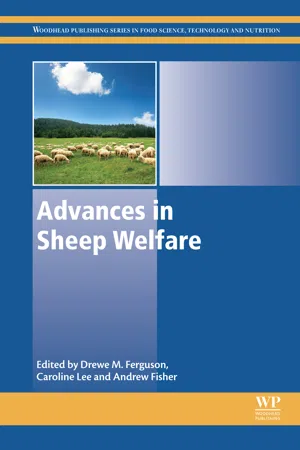
- 318 pages
- English
- ePUB (mobile friendly)
- Available on iOS & Android
Advances in Sheep Welfare
About this book
Advances in Sheep Welfare examines the recent advances made in sheep welfare assessment, handling and management, providing state-of-the-art coverage of the welfare needs of one of the world's most widely farmed animals.The book begins with an introduction to sheep welfare in Part One, with chapters covering biology and natural behavior, sheep production systems, and consumer and societal expectations for sheep products. Part Two goes on to highlight new advances in sheep welfare assessment, before Part Three outlines a wide range of solutions to sheep welfare challenges. The final section looks ahead to the future, considering what sheep welfare will look like in 2030 and beyond.This book is an essential part of the wider ranging series Advances in Farm Animal Welfare, with coverage of cattle, sheep, pigs and poultry.With its expert editors and international team of contributors, Advances in Sheep Welfare is a key reference tool for welfare research scientists and students, veterinarians involved in welfare assessment, and indeed anyone with a professional interest in the welfare of sheep.- Brings together top researchers in the field to provide a comprehensive overview of recent advances in the understanding of sheep welfare and management- Presents part of a wider series, Advances in Agricultural Animal Welfare, which provides comprehensive coverage of animal welfare of the world's major farmed animals- Highlights current advances and looks ahead to how sheep welfare management will develop in the next ten to fifteen years
Frequently asked questions
- Essential is ideal for learners and professionals who enjoy exploring a wide range of subjects. Access the Essential Library with 800,000+ trusted titles and best-sellers across business, personal growth, and the humanities. Includes unlimited reading time and Standard Read Aloud voice.
- Complete: Perfect for advanced learners and researchers needing full, unrestricted access. Unlock 1.4M+ books across hundreds of subjects, including academic and specialized titles. The Complete Plan also includes advanced features like Premium Read Aloud and Research Assistant.
Please note we cannot support devices running on iOS 13 and Android 7 or earlier. Learn more about using the app.
Information
Understanding the natural behaviour of sheep
Abstract
Keywords
Table of contents
- Cover
- Title page
- Table of Contents
- Copyright
- List of Contributors
- Preface
- Introduction
- Part One: Introduction to Sheep Welfare
- Part Two: New Advances in Sheep Welfare Assessment
- Part Three: Current and Future Solutions to Sheep Welfare Challenges
- Part Four: Sheep Welfare Beyond 2020
- Index